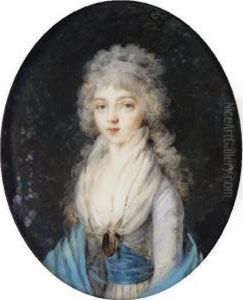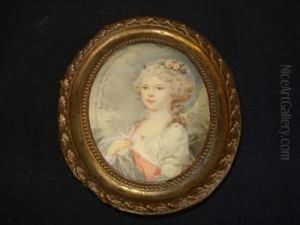Augustin Christian Ritt Paintings
Augustin Christian Ritt was a Russian engraver and miniaturist born in 1755, notable for his contributions to the art scene in Russia during the late 18th century. Although not as widely recognized as some of his contemporaries, Ritt's work provides a fascinating glimpse into the cultural and artistic milieu of his time. His career was notably marked by his position at the Russian court, where he served as a court artist, a role that granted him access to the highest echelons of society and allowed him to create portraits of significant figures of his era.
Ritt's artistic journey began in Europe, where he trained under prominent artists of the time, honing his skills in the delicate art of miniature painting—a form that was highly prized among the aristocracy of the 18th century for its intricacy and personal nature. Miniature painting required a meticulous technique and a deep understanding of color and light, skills that Ritt mastered and which set his work apart from his peers. Upon moving to Russia, he quickly gained favor at the court, reflecting the Russian elite's fascination with European art and culture.
Throughout his career, Ritt focused primarily on portraits, capturing the likenesses of his subjects with remarkable accuracy and sensitivity. His works were celebrated for their detail, elegance, and the ability to convey the personality and stature of the sitter. This was a period in Russian art where Western influences were becoming increasingly integrated into the country's artistic practices, and Ritt's work exemplified this blend of Russian and European styles.
Despite his success, detailed records of Ritt's life and works are somewhat scarce, and many of his pieces remain in private collections or within the archives of the Russian aristocracy. His death in 1799 marked the end of a relatively short, but impactful, career. Today, Augustin Christian Ritt's contributions to the world of miniature painting and his role in the cultural exchange between Russia and Europe during the 18th century continue to be subjects of interest for art historians and collectors alike. His legacy is preserved in the portraits that offer a window into the world of the Russian court and the artistic trends of the time.

